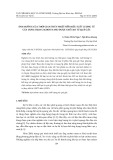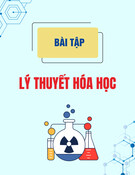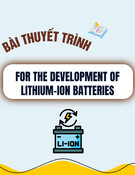
VNU Journal of Science: Natural Sciences and Technology, Vol. 41, No. 1 (2025) 70-80
70
Original Article
Study on the Determination of Perfluorocarboxylic Acids
(PFCAs) in House Dust Samples by Liquid Chromatography
Tandem Mass Spectrometry (LC-MS/MS) Method
Vu Thi Trang1, Luu Mai Anh2, Hoang Quoc Anh2, Tran Thi Lieu2,3,
Luu Thi Huyen Trang1, Kieu Thi Lan Phuong4, Nguyen Thi Duyen2,
Nguyen Xuan Thao2, Nguyen Thi Anh Huong2, Nguyen Thi Quynh Hoa5,*
1National Institute for Food Control, 65 Pham Than Duat, Hanoi, Vietnam
2VNU University of Science, 19 Le Thanh Tong, Hoan Kiem, Hanoi, Vietnam
3Vietnam National Institute of Occupational Safety and Health, 99 Tran Quoc Toan, Hanoi, Vietnam
4Poison Control Center, Bach Mai Hospital, 78 Giai Phong, Hanoi, Vietnam
5Hung Yen University of Technology and Education, Khoai Chau, Hung Yen, Vietnam
Received 21st May 2024
Revised 17th August 2024; Accepted 04th November 2024
Abstract: Perfluorocarboxylic acids (PFCAs) are an important group of per- and polyfluoroalkyl
substances (PFAS), which have been intensively produced and used due to their outstanding
features such as high resistance and water and oil repellency. However, these are also typical
organic pollutants with several adverse effects on environmental and human health. Studies on the
analytical methods for PFAS in general, and PFCAs in particular, in the environments are
necessary to characterize their potential emission sources and related health risks. In this study,
analytical procedure for simultaneous determination of 12 PFCAs (C5–C18) in house dust samples
was developed with 3 main steps: i) Dust samples were extracted by ultrasonication with
methanol; ii) Dust extracts were cleaned up by dispersive solid phase extraction with graphitized
carbon sorbent; and iii) Concentrations of PFCAs were determined by liquid chromatography
tandem mass spectrometry (LC-MS/MS) method. The method was validated for recovery
(72-95%), repeatability (RSD < 15%), and detection limits (0.10-1.0 ng/g). The proposed
analytical method can be applied in pollution monitoring and assessment of PFCAs in settled dusts
with several advantages like high accuracy, good detection ability at trace and ultratrace levels
(i.e., ng/g or lower) with rapid, simple sample preparation procedure.
Keywords: PFCAs, dust, ultrasonic extraction, dispersive solid phase extraction, LC-MS/MS.
D*
_______
* Corresponding author.
E-mail address: hoanguyen@utehy.edu.vn
https://doi.org/10.25073/2588-1140/vnunst.5689

V. T. Trang et al. / VNU Journal of Science: Natural Sciences and Technology, Vol. 41, No. 1 (2025) 70-80
71
Nghiên cứu phân tích một số perfluorocarboxylic acids
(PFCAs) trong mẫu bụi trong nhà bằng phương pháp sắc ký
lỏng ghép nối khối phổ hai lần (LC-MS/MS)
Vũ Thị Trang1, Lưu Mai Anh2, Hoàng Quốc Anh2, Trần Thị Liễu2,3,
Lưu Thị Huyền Trang1, Kiều Thị Lan Phương4, Nguyễn Thị Duyên2,
Nguyễn Xuân Thảo2, Nguyễn Thị Ánh Hường2, Nguyễn Thị Quỳnh Hoa5,*
1Viện Kiểm nghiệm An toàn Vệ sinh Thực phẩm Quốc gia, 65 Phạm Thận Duật, Hà Nội, Việt Nam
2Trường Đại học Khoa học Tự nhiên, Đại học Quốc gia Hà Nội,
19 Lê Thánh Tông, Hà Nội, Việt Nam
3Viện Khoa học An toàn và Vệ sinh Lao động, 99 Trần Quốc Toản, Hà Nội, Việt Nam
4Trung tâm Chống độc, Bệnh viện Bạch Mai, 78 Giải Phóng, Hà Nội, Việt Nam
5Trường Đại học Sư phạm Kỹ thuật Hưng Yên, Khoái Châu, Hưng Yên, Việt Nam
Nhận ngày 21 tháng 5 năm 2024
Chỉnh sửa ngày 17 tháng 8 năm 2024; Chấp nhận đăng ngày 04 tháng 11 năm 2024
Tóm tắt: Perfluorocarboxylic acids (PFCAs) là một nhóm hợp chất per- và polyfluoroalkyl
(PFAS) quan trọng được sản xuất và sử dụng phổ biến nhờ những tính chất ưu việt của chúng như
độ bền cao và khả năng chống bám dính. Tuy nhiên, đây cũng là các chất ô nhiễm hữu cơ điển
hình và có nhiều tác động tiêu cực đến sức khỏe môi trường và con người. Việc nghiên cứu
phương pháp phân tích các chất PFAS nói chung và PFCAs nói riêng trong môi trường là rất cần
thiết, góp phần tìm ra nguồn phát thải và ước tính rủi ro sức khỏe mà chúng có thể mang lại. Trong
nghiên cứu này, phương pháp phân tích đồng thời 12 chất PFCAs (C5–C18) trong mẫu bụi trong
nhà được phát triển bao gồm 3 bước chính như sau: i) Mẫu bụi được chiết bằng kỹ thuật chiết siêu
âm với methanol; ii) Dịch chiết mẫu được làm sạch bằng kỹ thuật chiết phân tán pha rắn với chất
hấp phụ carbon graphit; iii) Hàm lượng PFCAs được xác định bằng phương pháp sắc ký lỏng ghép
nối khối phổ hai lần (LC-MS/MS). Các thông số thẩm định phương pháp bao gồm: độ thu hồi
(72–95%), độ lặp lại (RSD < 15%) và giới hạn phát hiện (0,10–1,0 ng/g). Phương pháp phân tích
được khảo sát và phát triển có khả năng áp dụng trong các nghiên cứu quan trắc và đánh giá ô
nhiễm PFCAs từ bụi lắng với các ưu điểm như độ chính xác cao, khả năng phát hiện chất ở mức
hàm lượng vết và siêu vết (ng/g hoặc thấp hơn), quy trình xử lý mẫu nhanh, đơn giản.
Từ khóa: PFCAs, bụi, chiết siêu âm, chiết phân tán pha rắn, LC-MS/MS.
1. Mở đầu *
Các hợp chất per- và polyfluoroalkyl
(PFAS) là một nhóm chất halogen hữu cơ trong
đó các nguyên tử hydro trong mạch cacbon
được thay thế toàn bộ (per) hoặc một phần
(poly) bởi các nguyên tử flo [1]. Vì các liên kết
_______
* Tác giả liên hệ.
Địa chỉ email: hoanguyen@utehy.edu.vn
https://doi.org/10.25073/2588-1140/vnunst.5689
cacbon-flo có năng lượng phá vỡ liên kết rất lớn
(lên đến 130 kcal/mol), các hợp chất PFAS có
độ bền cao trong môi trường, có khả năng
chống lại sự phân hủy từ các tác nhân hóa lý và
sinh học và được coi là các “hóa chất vĩnh cửu”
(forever chemicals) [2]. Trong các PFAS,
perfluorocarboxylic acids (PFCAs) là một
nhóm hợp chất quan trọng được sản xuất và sử
dụng phổ biến nhờ những tính chất ưu việt của
chúng như độ bền cao và khả năng chống bám
dính [3]. Các chất PFCAs có nhiều ứng dụng

V. T. Trang et al. / VNU Journal of Science: Natural Sciences and Technology, Vol. 41, No. 1 (2025) 70-80
72
trong lớp phủ bề mặt chống dính, giấy, mực in,
vật liệu đóng gói và bọt chữa cháy [4]. Tuy
nhiên, PFCAs cũng là các chất ô nhiễm hữu cơ
điển hình và có nhiều tác động tiêu cực đến sức
khỏe môi trường và con người [5]. Các hợp
chất PFCAs đã được phát hiện trong nhiều
thành phần môi trường, các loài sinh vật và
trong cơ thể con người [6]. Việc tiếp xúc và
phơi nhiễm với PFAS nói chung và PFCAs nói
riêng được cho là có tác động tiêu cực đến sức
khỏe con người như ảnh hưởng đến chức năng
của tuyến giáp, hệ miễn dịch, hệ hô hấp, hệ sinh
sản và sự phát triển, có liên quan các bệnh ở
gan và thận và có khả năng gây ung thư [7].
Bụi lắng là một thành phần môi trường đặc
biệt có thể tích lũy nhiều nhóm chất ô nhiễm
hữu cơ do bụi có kích thước hạt nhỏ và khả
năng hấp phụ cao. Bụi lắng chứa các chất ô
nhiễm có thể đóng vai trò là một nguồn phơi
nhiễm đáng kể các chất độc hại này ở người
thông qua các con đường khác nhau như hít thở
không khí, nuốt phải hoặc tiếp xúc qua da [8].
PFAS đã được phát hiện trong mẫu bụi lắng
được thu thập tại nhiều quốc gia trên thế giới
như Nhật Bản [9], Canada [10], Thụy Điển
[11], Mỹ [12], Brazil [13], Ấn Độ [14], Anh
[15], Australia [13], Italy [16], Đài Loan [17],
Trung Quốc [13] trong vòng hơn 2 thập kỉ qua.
Sự hấp thụ bụi được cho là con đường phơi
nhiễm PFAS quan trọng trên cơ thể người, bên
cạnh con đường tiêu thụ thực phẩm và nước
uống [18].
Tại Việt Nam, sự có mặt của PFAS nói
chung và các chất PFCAs nói riêng đã được tìm
thấy trong nhiều thành phần môi trường như
nước, trầm tích, sinh vật và các sản phẩm tiêu
dùng như vật liệu tiếp xúc với thực phẩm [19].
Thông tin về sự có mặt và mức độ ô nhiễm của
các hợp chất này trong môi trường không khí và
bụi lắng ở nước ta còn rất hạn chế. Trong một
nghiên cứu mới được công bố bởi nhóm tác giả
Tan và cộng sự (2024), các mẫu bụi trong nhà
được thu thập tại Hà Nội (n = 21) để xác định
hàm lượng 31 hợp chất PFAS (bao gồm 11
PFCAs) [13]. Mẫu bụi được chiết siêu âm với
acetonitrile và dịch chiết được làm sạch với
chất hấp phụ carbon bằng kỹ thuật chiết phân
tán pha rắn (d-SPE) [13]. Hàm lượng tổng
PFAS trong các mẫu bụi tại Hà Nội (trung vị
24,1 ng/g) nhìn chung tương đương với mẫu tại
Brazil (17,3 ng/g) nhưng thấp hơn đáng kể so với
các khu vực khác tại Hong Kong (67,1 ng/g), Mỹ
(91,0 ng/g), Trung Quốc (118 ng/g) và
Australia (197 ng/g) [13]. Tuy nhiên, các
nghiên cứu về phát triển và thẩm định phương
pháp phân tích PFAS trong mẫu bụi còn chưa
được thực hiện tại các phòng thí nghiệm ở Việt
Nam. Trong nghiên cứu này, phương pháp phân
tích đồng thời 12 chất PFCAs trong mẫu bụi
trong nhà được phát triển bao gồm 3 bước
chính như sau: i) Mẫu bụi được chiết bằng kỹ
thuật chiết siêu âm; ii) Dịch chiết mẫu được làm
sạch bằng kỹ thuật d-SPE với chất hấp phụ
carbon graphit; iii) Hàm lượng PFCAs được
xác định bằng phương pháp sắc ký lỏng ghép
nối khối phổ hai lần (LC-MS/MS).
2. Phương pháp nghiên cứu
2.1. Chất chuẩn và hóa chất
Các dung dịch chuẩn PFCAs được cung cấp
bởi Wellington Laboratories Inc. (Canada) bao
gồm: dung dịch chất chuẩn không đánh dấu
đồng vị (PFAC-MXB), chất chuẩn đồng hành
(MPFAC-MXA) và chất nội chuẩn (M2PFOA).
Các PFCAs được nghiên cứu có mạch cacbon
C5, C6, C7, C8, C9, C10, C11, C12, C13, C14, C16 và
C18. Các chất đồng hành bao gồm: 13C2-PFHxA,
13C4-PFOA, 13C5-PFNA, 13C2-PFDA, 13C2-
PFUnDA và 13C2-PFDoDA. Chất nội chuẩn là
13C2-PFOA. Danh sách cụ thể bao gồm tên gọi,
ký hiệu, công thức cấu tạo và khối lượng mol
của các chất PFCAs được trình bày trong Bảng
1. Các dung dịch chuẩn làm việc bao gồm chất
phân tích, chất đồng hành và chất nội chuẩn có
nồng độ 10 ng/mL. Các dung dịch hiệu chuẩn
bao gồm chất đồng hành và chất nội chuẩn
(có nồng độ cố định 5 ng/mL) và chất phân tích
với nồng độ 0,1; 0,2; 0,5; 1; 2; 5; 10 và
20 ng/mL. Các dung dịch chuẩn PFCAs đều
được chuẩn bị trong metanol và bảo quản trong
các lọ thủy tinh tối màu ở nhiệt độ –4 °C. Các
hóa chất khác được sử dụng bao gồm: nước tinh
khiết sắc ký (LiChrosolv® water for
chromatography LC-MS grade; Supelco, Đức),
metanol (ChromAR® HPLC Super Gradient;

V. T. Trang et al. / VNU Journal of Science: Natural Sciences and Technology, Vol. 41, No. 1 (2025) 70-80
73
Macron Fine Chemicals, Đức), axit axetic
(99,5%; Macron Fine Chemicals, Đức), amoni
axetat (98%; Merck KGaA, Đức), natri sunfat
(98%; Merck KGaA, Đức), cacbon graphit
(Carbon SPE Bulk Sorbent; Agilent
Technologies, Mỹ).
Bảng 1. Các chất PFCAs và chất chuẩn đánh dấu đồng vị sử dụng trong nghiên cứu này
Tên chất
Ký hiệu
Vai trò
Công thức
M
Perfluoropentanoic acid
PFPeA
Chất phân tích
CF3(CF2)3COOH
264
Perfluorohexanoic acid
PFHxA
Chất phân tích
CF3(CF2)4COOH
314
Perfluoroheptanoic acid
PFHpA
Chất phân tích
CF3(CF2)5COOH
364
Perfluorooctanoic acid
PFOA
Chất phân tích
CF3(CF2)6COOH
414
Perfluorononanoic acid
PFNA
Chất phân tích
CF3(CF2)7COOH
464
Perfluorodecanoic acid
PFDA
Chất phân tích
CF3(CF2)8COOH
514
Perfluoroundecanoic acid
PFUnDA
Chất phân tích
CF3(CF2)9COOH
564
Perfluorododecanoic acid
PFDoDA
Chất phân tích
CF3(CF2)10COOH
614
Perfluorotridecanoic acid
PFTrDA
Chất phân tích
CF3(CF2)11COOH
664
Perfluorotetradecanoic acid
PFTeDA
Chất phân tích
CF3(CF2)12COOH
714
Perfluorohexadecanoic acid
PFHxDA
Chất phân tích
CF3(CF2)14COOH
814
Perfluorooctadecanoic acid
PFODA
Chất phân tích
CF3(CF2)16COOH
914
13C2-Perfluorohexanoic acid
13C2-PFHxA
Chất đồng hành
CF3(CF2)4COOH
316
13C4-Perfluorooctanoic acid
13C4-PFOA
Chất đồng hành
CF3(CF2)6COOH
418
13C5-Perfluorononanoic acid
13C5-PFNA
Chất đồng hành
CF3(CF2)7COOH
469
13C2-Perfluorodecanoic acid
13C2-PFDA
Chất đồng hành
CF3(CF2)8COOH
516
13C2-Perfluoroundecanoic acid
13C2-PFUnDA
Chất đồng hành
CF3(CF2)9COOH
566
13C2-Perfluorododecanoic acid
13C2-PFDoDA
Chất đồng hành
CF3(CF2)10COOH
616
13C2-Perfluorooctanoic acid
13C2-PFOA
Chất nội chuẩn
CF3(CF2)6COOH
416
t
2.2. Mẫu bụi
Mẫu bụi (n = 20) được thu thập trong các
nhà ở tại Hà Nội từ tháng 12/2021 đến tháng
12/2023. Các mẫu bụi được thu thập bằng
phương pháp quét thủ công với chổi và xẻng
hót trên nền nhà và bề mặt đồ gia dụng, hoặc
được thu thập từ túi lọc bụi của máy hút bụi
dùng trong nhà. Mẫu sau khi thu thập được
chuyển vào phoi nhôm, gói lại và giữ trong túi
polyetylen có khóa zip. Tại phòng thí nghiệm,
mẫu bụi được loại bỏ các dị vật có kích thước
lớn như mảnh nhựa, kim loại, thủy tinh, tóc, rồi
được rây qua sàng bằng thép không gỉ có khẩu
độ 100 μm để đồng nhất. Mẫu bụi được sử dụng
trong nghiên cứu này là một mẫu gộp đại diện
được chuẩn bị bằng cách trộn đều khoảng 2 g
các mẫu bụi nói trên, chuyển vào chai thủy tinh
tối màu, bảo quản ở nhiệt độ phòng và tránh
ánh sáng trực tiếp.
2.3. Nghiên cứu điều kiện d-SPE
Độ thu hồi của các PFCAs trong bước
d-SPE với cacbon graphit được thực hiện như
sau: i) Chuẩn bị ống thủy tinh 10 mL có dung
dịch chuẩn chứa 2,5 ng các PFCAs và chất
đồng hành trong 2 mL metanol với 5 mM axit
axetic; ii) Thêm cacbon graphit; iii) Lắc xoáy
để phân tán chất hấp phụ với tốc độ
2000 vòng/phút trong 1 phút; iv) Li tâm ống
thủy tinh với tốc độ 3500 vòng/phút trong
10 phút; v) chuyển pha dung dịch sang ống cô
đặc mẫu; vi) pha rắn được thêm 2 mL dung môi

V. T. Trang et al. / VNU Journal of Science: Natural Sciences and Technology, Vol. 41, No. 1 (2025) 70-80
74
và lặp lại bước (3)-(5); vii) Cô đặc dung dịch
dưới dòng khí N2 ở 50 °C đến gần cạn;
viii) Thêm 2.5 ng chất nội chuẩn và chuyển
mẫu vào 500 μL metanol; và ix) Lọc dung dịch
qua màng lọc nylon 0,22 μm vào ống chứa mẫu
trước khi phân tích trên hệ thống LC-MS/MS.
Lượng chất hấp phụ được khảo sát bao gồm 50,
100 và 500 mg.
2.4. Nghiên cứu điều kiện chiết siêu âm
Điều kiện chiết siêu âm được nghiên cứu
trên thiết bị bể rung siêu âm (WUC-32; 40 kHz;
Shenzhen Jiayuanda Technology Co., Ltd,
Trung Quốc). Hai dung môi chiết được khảo sát
là metanol (M) và metanol có chứa 5 mM axit
axetic (A). Mẫu được nghiên cứu bao gồm:
(1) Mẫu trắng 0,2 g Na2SO4 thêm chuẩn 2,5 ng
chất đồng hành; (2) Mẫu bụi 0,2 g thêm chuẩn
2,5 ng chất đồng hành; (3) Mẫu bụi 0,2 g thêm
chuẩn 2,5 ng chất phân tích và 2,5 ng chất đồng
hành. Như vậy các mẫu được khảo sát bao gồm:
M0, M1, M2, A0, A1, A2, trong đó M và A là
dung môi chiết metanol và metanol chứa 5 mM
axit axetic, 0, 1, 2 chỉ mẫu trắng, mẫu bụi
không thêm chuẩn chất phân tích và mẫu bụi
thêm chuẩn chất phân tích.
Quy trình chiết mẫu và xử lý dịch chiết bao
gồm các bước như sau: i) Cân 0,2 g mẫu và
chuyển vào ống thủy tinh 10 mL; ii) Thêm
chuẩn chất đồng hành và chất phân tích;
iii) Thêm 3 mL dung môi; iv) Lắc vortex trong
1 phút để đồng nhất; v) Chiết siêu âm với bể
rung trong 10 phút; vi) Li tâm với tốc độ 3500
vòng/phút trong 10 phút; vii) Chuyển phần dịch
chiết vào ống thủy tinh khác; viii) Lặp lại các
bước (3)-(7) thêm 1 lần nữa; ix) Cô đặc dung
dịch dưới dòng khí N2 ở 50 °C đến 2 mL;
x) Làm sạch mẫu với 50 mg cacbon theo quy
trình tại mục 2.3; và xi) Thêm 2,5 ng chất nội
chuẩn, chuyển mẫu vào 500 μL metanol, lọc
dung dịch qua màng lọc nylon 0,22 μm vào ống
chứa mẫu trước khi phân tích trên hệ thống
LC-MS/MS.
2.5. Nghiên cứu điều kiện phân tích và định
lượng PFCAs trên hệ thống LC-MS/MS
Các điều kiện phân tích PFCAs trên hệ
thống LC-MS/MS được tham khảo từ nghiên
cứu trước đây của chúng tôi [19] và được trình
bày trong Bảng 2.
Bảng 2. Điều kiện của hệ thống LC-MS/MS
cho phân tích PFCAs
Điều kiện
Thông số
Hệ thống
LC-MS/MS
ExionLCTM AD với Triple
Quad 6500+ (SCIEX)
Cột tách
Symmetry C18 (3,5 μm × 2,1
mm × 150 mm; Waters)
Cột bảo vệ
C18 VanGuard Pre-Column
(1.7 μm × 2,1 mm × 5 mm;
Waters)
Nhiệt độ
25 °C
Pha động
Kênh A (2 mM amoni axetat/
metanol, 9/1, v/v); Kênh B
(metanol)
Chương trình
gradient (%B)
30% (2 phút); 30%–90%
(2–12 phút); 90% (12–16 phút);
90%–30% (16–18 phút); 30%
(18–20 phút)
Tốc độ dòng
0,25 mL/phút
Thể tích mẫu
5 μL
Khí curtain
35 psi
Khí collision
8 psi
Khí ion source
50 psi
Nhiệt độ nguồn
ion
300 °C
Chế độ ion hóa
Phun điện tích âm (ESI–)
Chế độ đo
Quan sát đa phản ứng (MRM)
Thế phun ion
–4500 V
Thế entrance
–10 V
Hàm lượng PFCAs trong mẫu bụi (ng/g)
được tính dựa trên tín hiệu của dãy chuyển khối
m/z định lượng (chất phân tích và chất đồng
hành), lượng chất đồng hành thêm vào mẫu
(ng), khối lượng mẫu bụi (g) và hệ số đáp ứng
của tín hiệu chất phân tích/chất đồng hành thu
được từ dung dịch chuẩn. Độ thu hồi của chất
phân tích được xác định dựa trên tỉ lệ % của
lượng chất thêm chuẩn đo được và lượng chất
thêm chuẩn vào mẫu. Độ thu hồi của chất đồng
hành được xác định dựa trên tín hiệu của dãy












![Đề thi kết thúc học phần Nguyên lí Hóa học 2 [mới nhất]](https://cdn.tailieu.vn/images/document/thumbnail/2025/20251014/anhinhduyet000/135x160/69761760428591.jpg)













